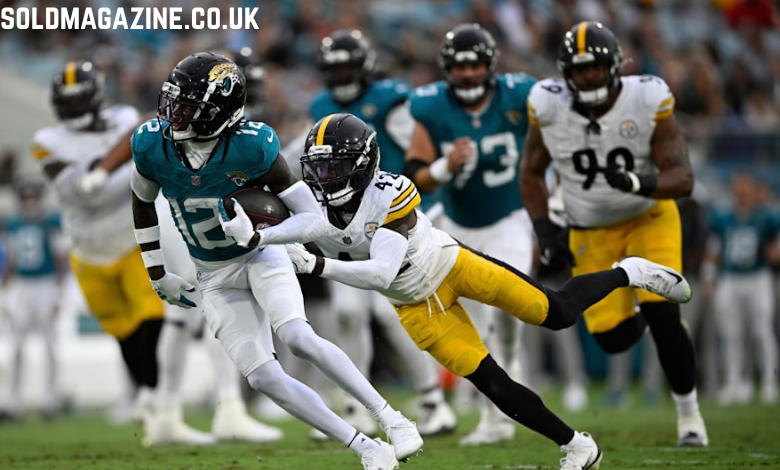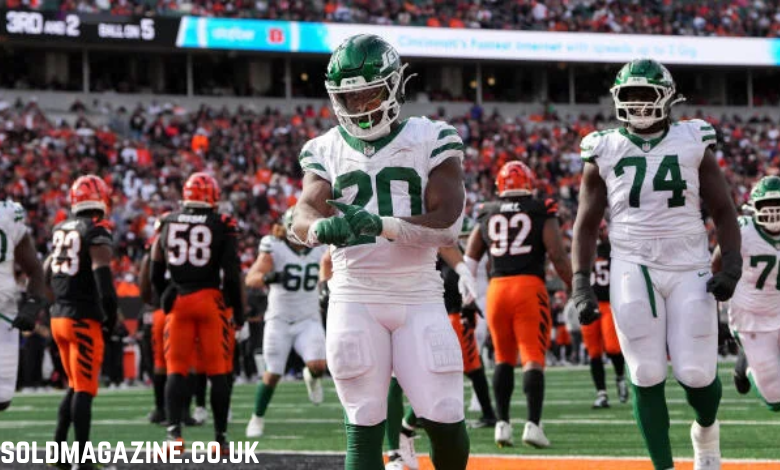Introduction
The recent matchup between the Jacksonville Jaguars and the Chicago Bears ended in a 35–16 victory for Chicago. The game highlighted a clear difference in execution, consistency, and control on both sides of the ball. Chicago’s offense functioned smoothly through accurate passing and steady ground gains, while Jacksonville continued to struggle with maintaining drives and defending against explosive plays. This game provided a clear picture of how each team’s key players performed under pressure.
First Quarter Breakdown
The Jaguars began the game on a positive note, managing to get on the scoreboard first. After a series of short drives from both teams, Jacksonville executed a 14-play, 67-yard drive that resulted in a field goal, giving them a 3-0 lead. This drive showed early promise, with their quarterback managing short, precise passes and the running backs contributing small yardage gains to keep the chains moving.
Chicago’s opening possessions, however, were less productive. The Bears went three-and-out on their first two drives, as Jacksonville’s defense held strong against the run and limited short passes. The Jaguars’ defense showed good containment during the first quarter, forcing punts and controlling time of possession.
By the end of the first quarter, Jacksonville led 3-0, but the lack of a touchdown hinted at a problem that would continue throughout the game—finishing drives effectively.
Second Quarter: The Game Turns Around
The second quarter completely shifted momentum in favor of the Bears. Chicago began the period by establishing rhythm on offense. A 7-play, 81-yard drive resulted in their first touchdown, giving them a 7-3 lead. The play-calling became more dynamic, mixing quick slants, play-action passes, and inside runs that broke through Jacksonville’s defensive front.
Jacksonville’s offense stalled repeatedly during this quarter. Several drives ended quickly—5 plays for 17 yards, 3 plays for 6 yards, and 3 plays for 8 yards. They were unable to build on their early field goal and failed to cross midfield for most of the quarter.
The Bears capitalized on this with another long drive, marching 85 yards in 10 plays to score again, extending their lead to 14-3. Their quarterback displayed composure and accuracy, finding open targets on key downs, while their running back consistently moved the chains with gains of 6 to 8 yards.
The Jaguars went into halftime trailing 14-3, with clear issues in offensive rhythm and defensive fatigue starting to appear.
Third Quarter: Effort to Recover
Coming out of halftime, the Jaguars had a chance to reset. Unfortunately, their first possession ended in a costly fumble after just one play, setting up the Bears with favorable field position. Chicago quickly turned that mistake into points with a 7-play, 41-yard drive ending in another touchdown. The score jumped to 21-3, and the Jaguars’ defense looked unsettled.
To their credit, Jacksonville responded on the next drive. The offense finally strung together 11 plays for 70 yards, ending with a touchdown that cut the deficit to 21-10. Their quarterback led this drive efficiently, using short passes and involving multiple receivers to spread out the Bears’ defense. This was one of the few moments where the Jaguars’ offensive plan seemed to click.
The third quarter ended with a faint sign of hope for Jacksonville, but their defense still struggled to slow down Chicago’s balanced attack.
Fourth Quarter: Bears Seal the Game
The final quarter demonstrated why the Bears are considered a team capable of closing out games effectively. They opened with a strong 10-play, 70-yard drive, once again finishing in the end zone to make it 28-10. The Jaguars’ secondary failed to contain short-to-intermediate passes, and missed tackles allowed extra yardage that turned routine plays into scoring threats.
Jacksonville’s next drive ended quickly after an interception. The Bears capitalized again, needing just three plays to cover 36 yards and extend their lead to 35-10. At this point, Chicago controlled every aspect of the game—clock management, field position, and composure.
The Jaguars added a late touchdown after a long 17-play drive spanning 70 yards, cutting the score to 35-16. While it showed effort, it came too late to change the outcome. Chicago ended the game calmly, running down the clock on their final possession.
Offensive Performance Analysis
Jacksonville Jaguars:
The Jaguars’ quarterback completed the majority of his passes, ending with over 230 yards and two touchdowns. However, turnovers and an inconsistent run game hurt them. The offensive line allowed pressure that limited his ability to throw deep. Their running game produced fewer than 70 total rushing yards, with no player crossing 30 yards individually. This lack of balance forced the quarterback to throw often, allowing Chicago’s defense to anticipate plays.
Chicago Bears:
Chicago’s offense was efficient and balanced. Their quarterback was highly accurate, throwing four touchdowns and completing over 75% of his passes. The offensive line gave him the time needed to make confident throws. The running game, led by their featured back with around 90 yards and a touchdown, kept drives alive and helped maintain control of the tempo.
The Bears also excelled in red-zone efficiency, turning nearly every visit inside the 20 into a touchdown. This level of execution was the major difference between both teams.
Defensive Highlights
Jaguars Defense:
Early in the game, Jacksonville’s defense looked prepared. They held Chicago to minimal gains in the first quarter and forced quick punts. However, as the game progressed, they couldn’t contain the Bears’ running lanes or defend short passes over the middle. The secondary struggled with coverage breakdowns, allowing multiple touchdowns to tight ends and slot receivers. The front line managed a few pressures but could not produce consistent sacks.
Bears Defense:
Chicago’s defense deserves full credit for dictating the pace. They contained the Jaguars’ run game early, which made Jacksonville one-dimensional. The Bears forced two key turnovers—a fumble and an interception—both of which directly led to scoring drives. Their pass rush forced hurried throws, and their secondary played tight coverage on third downs. The discipline of their defensive unit limited Jacksonville to just 16 points despite several long drives.
Special Teams and Possession Game
Field position played an important role. Chicago’s punter consistently pinned the Jaguars deep in their own half, making it harder for Jacksonville to sustain drives. The Jaguars’ punting unit was active throughout the game, indicating their struggles to advance the ball beyond midfield.
A missed field goal by Chicago in the fourth quarter did not impact the outcome, but it was one of the few minor setbacks for them in an otherwise clean performance.
Time of possession favored the Bears, as their long, methodical drives kept the Jaguars’ defense on the field. That fatigue became visible late in the game when the Bears scored consecutive touchdowns in quick succession.
Individual Player Stats Overview
For the Jaguars:
- Quarterback: Threw for over 230 yards with two touchdowns but also had one interception.
- Running Backs: Combined for around 60 rushing yards, averaging under 4 yards per carry.
- Wide Receivers: Their top target caught 6 passes for about 70 yards and one touchdown, while others added short receptions to move the chains.
- Defense: The leading tackler recorded 8 total tackles, but there were few standout plays such as sacks or forced turnovers.
For the Bears:
- Quarterback: Completed nearly 80% of passes for over 220 yards and four touchdowns. His accuracy under pressure was notable.
- Running Back: Led all rushers with about 90 yards and a touchdown, helping maintain offensive balance.
- Receivers: Two receivers scored twice each, with solid gains on intermediate routes that exploited the Jaguars’ soft coverage.
- Defense: Recorded multiple sacks and turnovers, keeping the Jaguars’ offense from finding any rhythm.
Game Statistics Summary
| Category | Jaguars | Bears |
|---|---|---|
| Total Points | 16 | 35 |
| Total Yards | 278 | 373 |
| Passing Yards | 234 | 226 |
| Rushing Yards | 68 | 152 |
| Turnovers | 2 | 1 |
| First Downs | 17 | 25 |
| Time of Possession | 27:30 | 32:30 |
This table sums up why the Bears dominated. They gained nearly 100 more total yards and doubled Jacksonville’s rushing output. More first downs and better possession control allowed them to dictate the flow of the game.
Turning Points of the Match
Fumble Early in Third Quarter – The Jaguars opened the second half with a turnover that immediately led to a Bears touchdown, widening the gap.
Red-Zone Efficiency – Chicago’s ability to convert long drives into touchdowns contrasted sharply with Jacksonville’s reliance on field goals.
Interception in Fourth Quarter – This mistake ended any comeback hopes and gave the Bears another short-field opportunity.
Dominant Rushing Performance – Chicago’s running game wore down Jacksonville’s defense, controlling the clock and momentum.
Each of these moments shifted momentum clearly toward the Bears and exposed the Jaguars’ lack of depth and adaptability.
Team Assessment
Jacksonville Jaguars:
The Jaguars showed flashes of capability but lacked consistency. Their quarterback performed decently under pressure, yet the absence of a reliable run game and repeated short possessions undermined their scoring chances. The defense showed effort but allowed too many yards after contact and could not stop the Bears on third downs.
For improvement, Jacksonville needs better offensive line protection, a stronger ground attack, and more aggressive defensive coverage to prevent early scoring runs from opponents.
Chicago Bears:
Chicago demonstrated what complete football looks like. The offense executed smoothly, with precise passing, strong rushing, and effective use of time. Their quarterback displayed poise, while the defense forced errors and limited big plays. The coaching staff deserves credit for maintaining discipline and not letting the team lose focus after halftime.
Key Lessons from the Game
Efficiency Wins Games: Chicago converted most drives into points. Jacksonville struggled to capitalize on long possessions.
Balance Is Critical: A good mix of run and pass kept the Bears unpredictable, whereas the Jaguars leaned heavily on passing.
Turnovers Decide Outcomes: Each Jacksonville turnover resulted in a scoring drive for Chicago.
Field Position Matters: Chicago repeatedly started with favorable field position due to better special teams and defensive stops.
Conclusion
The Bears’ 35-16 win over the Jaguars was more than just a scoreline—it reflected control, preparation, and composure. Chicago’s players executed their roles efficiently, with the quarterback leading a balanced offense that dominated both on the ground and through the air. The Jaguars, on the other hand, faced the same challenges that have plagued them all season: inconsistent execution, poor protection, and defensive lapses. For Jacksonville, the loss serves as a reminder of how turnovers and weak rushing can undo good efforts from the passing game. For Chicago, this victory reinforces their upward momentum and showcases the strength of a young, well-coordinated offense supported by a disciplined defense.
In the end, the match highlighted one simple truth in football—teams that protect the ball, sustain drives, and execute efficiently usually walk away with the win. The Bears did all three. The Jaguars must now focus on fixing their fundamentals before their next outing.
FAQS
1. Who was the top performer in the Jacksonville Jaguars vs Chicago Bears match?
Chicago’s quarterback led with four touchdowns and a strong completion rate, making him the standout performer of the game.
2. How did the Jaguars’ offense perform in the match?
The Jaguars showed moments of rhythm but struggled with turnovers and short drives that limited their scoring chances.
3. What was the key difference between the Bears and Jaguars’ performances?
The Bears maintained offensive balance with strong rushing and passing, while the Jaguars relied too heavily on their quarterback.
4. Which team had better defensive control in the game?
Chicago’s defense dominated, forcing two turnovers and restricting Jacksonville’s rushing game throughout the four quarters.
5. What was the final score of the Jacksonville Jaguars vs Chicago Bears game?
The Chicago Bears defeated the Jacksonville Jaguars with a final score of 35–16.




